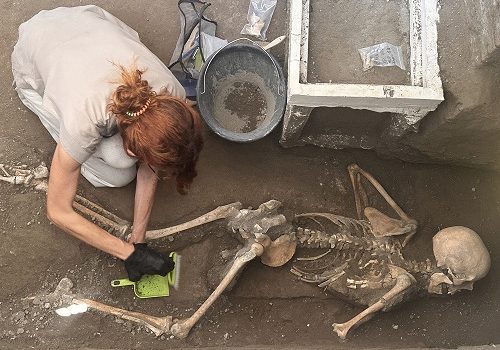Pompeii, the remains of two more victims of the eruption found in Region IX
A man and a woman with a small cache of treasure consisting of coins and precious jewellery
Finds continue to be made in the excavations of Region IX, Insula 10 in Pompeii, where archaeological investigations are underway as part of a larger project to secure the edge of the site.
The latest discovery, an initial scientific report on which has just been published in the E-Journal of the Archaeological Park of Pompeii, is a room inside which two victims of the eruption, a man and a woman, were found. The woman was found on the bed and was carrying a small cache of treasure with gold, silver and bronze coins, and some jewellery including a pair of gold and pearl earrings.
The small room, a service area used as a temporary cubiculo (bedroom) during the renovation of the house, is located to the south of the Blue Shrine room that emerged recently, and has access to the large living room decorated in second style plaster. The room was chosen as a refuge by the two people, while waiting for the end of the fall of pumice that had been gradually filling the open spaces for hours in the rest of the house. The room, thanks to the doorways having been closed, remained free of the pumice that had filled the adjoining rooms, effectively blocking the two victims' ability to open a door and escape. Trapped in the cramped little room, their deaths were caused by the pyroclastic flow that buried them.
The impressions left in the ash by decomposed organic matter made it possible to reconstruct the furnishings by casting the voids and thus identifying their exact position at the time of the eruption: a wooden bed, stool, chest, and table with a marble top, on which sat bronze, glass and ceramic objects still in place. A bronze candelabrum had toppled over in the room.
The excavation project is part of a broader approach, which has been developed in recent years with the aim of improving and stabilising the sloped edge of the site and managing the hydrogeological situation along it. Based on the data collected during this period, the Archaeological Park is committed to calibrating its approach, focusing on the aspects of restoration, preservation and accessibility of the ancient remains and carefully limiting the excavation areas within the city buried in AD 79. At the same time, important ministerial and governmental investments are earmarked for new excavations in the territory outside the walls of Pompeii, from the villa at Civita Giuliana to the Villa of the Mysteries, and ancient Oplontis in the municipality of Torre Annunziata.
"The opportunity to analyse the invaluable anthropological data relating to the two victims found within the archaeological context that marked their tragic end, allows us to recover a considerable amount of information about the daily life of the ancient Pompeiians and the micro-histories of some of them, with precise and timely documentation, confirming the uniqueness of the Vesuvian territory. – declares Park Director Gabriel Zuchtriegel – A work in which archaeologists, anthropologists and volcanologists work together to reconstruct the last moments of the lives of men, women and children who perished during one of the greatest natural catastrophes of antiquity. Pompeii remains an important site for research and conservation, but in the coming years we expect significant developments in the archaeological excavations and in the accessibility and understanding of the local territory as well, thanks to The Interministerial Committee for Economic Planning and Sustainable Development (CIPESS) investments recently announced by the Minister of Culture, Gennaro Sangiuliano."
Photos of the victims: https://we.tl/t-MFniLKiafu
Video of the Director and general coverage: https://we.tl/t-bVx3HVMqUN
Link to Pompeii’s E-journal on the victims: https://pompeiisites.org/e-journal-degli-scavi-di-pompei/


